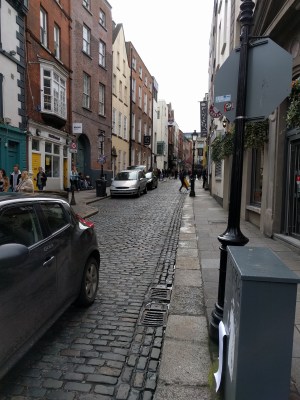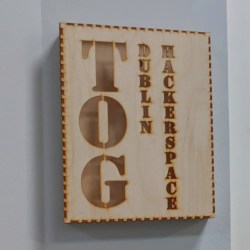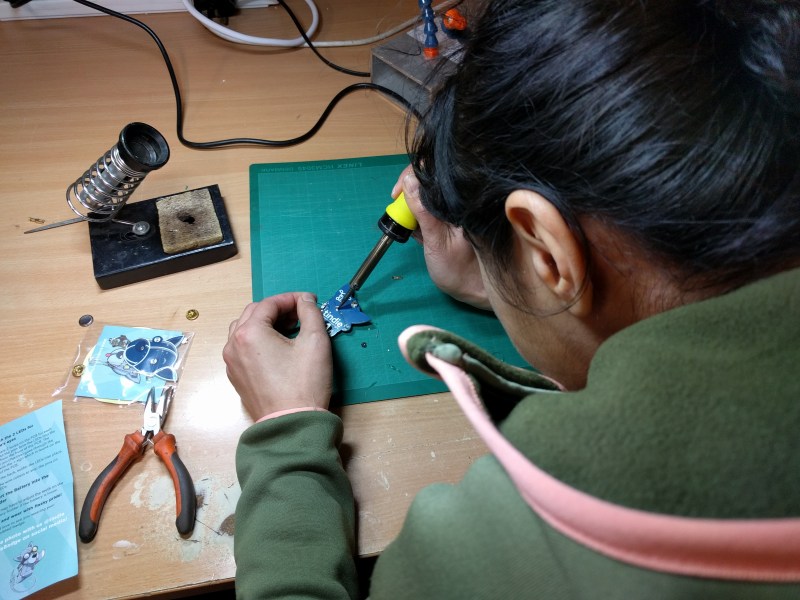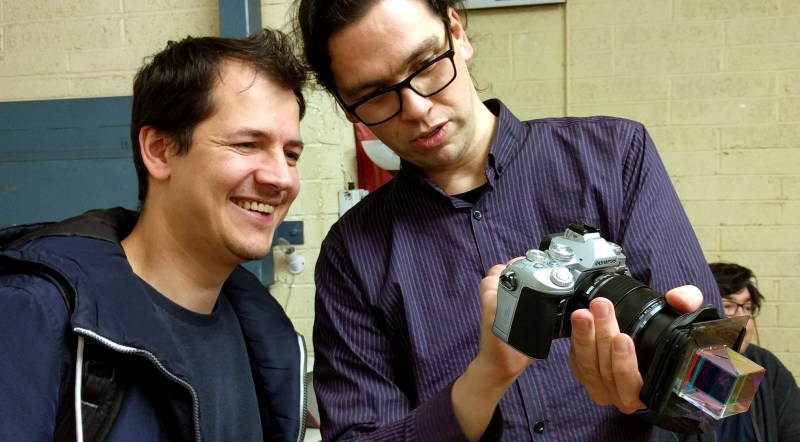When on the road, we love to stop by a local hackerspace and connect with the hacker community. On Friday, TOG Hackerspace in Dublin, Ireland opened their doors to host a Bring-a-Hack with Hackaday and Tindie.
 The city center of Dublin is anything but a grid. The cobblestone roads meander every which way and are a puzzle of one-way and surprise construction, none of which seemed to faze Google’s navigation algorithms. I was happy to be operating the smartphone instead of the rental vehicle. A big thanks goes to Jenny List for taking on the stress of driving on our refreshments run without coming in contact with people or cars.
The city center of Dublin is anything but a grid. The cobblestone roads meander every which way and are a puzzle of one-way and surprise construction, none of which seemed to faze Google’s navigation algorithms. I was happy to be operating the smartphone instead of the rental vehicle. A big thanks goes to Jenny List for taking on the stress of driving on our refreshments run without coming in contact with people or cars.
You’re likely wondering why the street layout of the city deserves such attention. I’m used to centrally-located Hackerspaces being tight on space, and indeed the members of TOG cautioned us that 50 people would feel cramped. Much the opposite, the pubs, restaurants, hotels, and performing arts centers are not small, nor winding, nor made of cobblestones. Dublin is a fantastic place to party, with plenty of space for us hardware geeks to congregate. TOG itself, which about 20 minutes walk from the central Temple Bar area (where this image was taken), even has a small parking lot which made our beer drop off and pizza delivery a breeze.
 A Tour of TOG Hackerspace
A Tour of TOG Hackerspace
TOG is a Gaelic word which loosely translates as “to make”. Declan met us for the beer drop and gave us a tour when we returned for the evening event. The building is divided into several different spaces, starting with an entry area that serves as a meeting space, gaming room, and showcase of projects.
Where you might see prayer flags strung up on an apartment building, we see floppy disks (both the hard and soft variety) strung around the meeting area. Declan has a shamrock of K’nex parts wired up with a microphone controlled RGB LED strip — it’s like a test your strength game to see who can shout the coolest colors.
I also really enjoyed the fabric anatomy display that has snaps on each organ and only lights up the labels if you complete the circuits in the correct locations.
These are just the tip of the iceberg. There’s much more after the break so join me for the rest of the tour, and some of the notable hacks that showed up on Friday evening.
Interspersed with two different arcade cabinets chock full of emulators, you’ll find a swag and refreshments stall on the pay-by-honor-system basis. In true hacker form, TOG imports Club Mate for its members (you’ll see evidence of this in a bit).
Featured prominently when you first walk into this room is a registration computer. As anyone who has dealt with insuring a hackerspace can tell you, having visitors register upon arrival is a part of the welcome dance. TOG has quite a collection of Rubber Duckies on display in this area as well (the bathtime fun kind, on the infosec kind). The duck figure is found in projects throughout the space and is the outline of their t-shirt design. This dates from a rubber duck river run in Dublin from many years back.
Project Demos
Remember that fantastic bone-conducting radio which Jenny List reported on a couple of summers ago? This comes straight out of TOG and is on display as we move past the meeting area into the project spaces. Also on display is a machine that will read your palm to tell your future and a plethora of laser-cut project examples.
There is a large lock picking contingent among hackerspace members here, it just so happens there’s a bridge in Dublin where it’s popular to leave locks on the handrails. This is actually a problem in some cities as locks are heavy and thousands of them can add up to over-weight issues on the infrastructure. TOG are doing their part by lock-picking the “graffiti” and they have quite a collection of the salvage going. I think they should team up with the city and make it an open event each year for people to learn to pick and reclaim a lock over a beautiful fall weekend each year.
I already mentioned the Club Mate import habits at TOG but I glossed over the scale of them. I’m uncertain as to how long this has been going on, but here are scores of these boxes — the ones above are full of Mate, and the ones below used for project and parts storage throughout the space. If you’re going to have a drinking problem, this carbonated and caffeinated tea beverage in iconic bottles is one thing that keeps the hacking going.
For cord storage, the tin can used as shelves is a neat trick for cable and adapter storage. This is just outside the electronics room.
Dedicated Use Rooms
The laser cutting room and electronics room are combined. In the far corner from the door is a large cutter built using the Lasersaur open source plans. Word is the cutter is a bit slow but does a great job. The electronics area has a handful of very nicely organized soldering positions along one wall, with benches for other electronics work, as well as tidy component storage along another.
The woodshop was surprisingly dust free and featured a good assortment of woodworking tools. A formidable CNC router/mill was built by a member and it sounds like a rite of passage is to get yourself trained in on the equipment by milling your own wooden drink coaster.
Just outside the entrance to woodshop is a large common area. About 1/3 of it is project storage, using racks of large, heavy-duty plastic storage bins. The other 2/3 of the area is the large project source materials area. Declan called it the “ever-dwindling pile of stuff” which seems backwards to us. Most spaces accumulate way too much but TOG is winning the junk war by clearing out unused materials over time.
Two of the really neat member projects in the back are the LED tower and the automatic loom. The loom was originally designed to be powered by punch-cards. This one was digitized with a hobby servo for each of the rods that follow the holes. The LED tower is much like an LED cube, if you stacked like 7 of them on top of one another!
The Hacks
I did a horrible job of putting names with hacks this time around so please self-identify in the comments below (and link to more details if you’ve already published them).
In the Things That Make You Scratch Your Head category, did you know that some really large DLP projectors use a 3-way prism to combine the three colors of light for a full-color projection? I didn’t know it and certainly had never seen the really awesome prism which is being used in reverse for this hack. It’s mounted on a lens adapter and the sensor in the DSLR is getting a composite image of 3 different colors — one coming from the front and the other two coming in at 90 degree angles (opposite of one another). The effect is surreal and beautiful. Take a look at the album Sebastian Dooris has put together using this setup. He even posted an album of images from this meetup!
This wireless parking notifier system is ingenious. This hacker shares one parking spot with his neighbor. If the spot is already occupied it’s an awkward reversing (remember those narrow roads) and going to the other side of the complex to communal parking. This hardware lets him quickly check on a smartphone app to see where he should go park. It uses ultrasonic to detect the vehicle and 433 MHz for wireless communications.
We had a Tindie seller turn up with a wide assortment of the products he’s developed for his store. He is the owner of the AnalysIR store and started just with some IR “toys” — fun ways to interact with 38 kHz signals and had such success he’s been dreaming up new boards like crazy. The metal cans you see are frequency standards for calibrating the IR carrier signal. Interestingly enough, these are being salvaged from recycled electronics in China and sold at the usual places.
I usually try to watch the names going by when we ask for RSVPs but I somehow missed Mike Harrison’s name and was ecstatic when he showed up. You may know him from his YouTube channel mikeselectricstuff but you should also know him from his amazing badge design for the 2017 Hackaday Superconference. He was showing that badge off as well as a flexible PCB with a bazillion small-pitch white LEDs making up a matrix.

Tindie’s most sought-after swag these days is the hardware badge we developed. Not only was Jasmine Brackett handing them out to all who were interested, people at the meetup heated up TOG’s soldering stations and had a badge populating party.
We had a wonderful time at this Bring-a-Hack. Thank you to all the members of TOG Hackerspace who opened their doors for the event, and got everyone excited about the Hackaday Dublin Unconference on the following day. We’ll be publishing articles about the Unconference this week so keep your eye on Hackaday.
Whether you missed out on this meetup, or had a ton of fun and want to be in on the next big thing, check out the Science Hack Day hosted at TOG weekend after next.














































Sincere thanks to you and your team in organizing an unconference in Dublin this year. Between the people, props and presentations it was easily the best tech related event I’ve ever attended here. I really hope you enjoyed your visit and that you come back to Ireland again soon!
Alex (that magnetic tracking guy)
That prism thing is really cool. I was wondering whether one could use it for something practical…
The thing they’re “best” for is what they’re designed for: combining color channels from three different sources into a single RGB image. Which is exactly what you want for a DIY RGB laser. (Hint, hint.)
Its original purpose combines three images into one for projection, so you could do that. Could be different images entirely instead of different color channels of the same image. Or use it in reverse to split out different wavelengths, as they are doing. What for? The only limit is your imagination!
I have a couple of those dichroic prisms. I want to make a rig that captures stereoscopic video already anaglyph’d to send down a standard video transmission channel.
You mean a red and blue channel from slightly different perspectives? That’s interesting, good idea. Seems like it would be fairly doable with a few mirrors, maybe a couple filters.
Sounds like cool project, but you don’t need (or even want) an X-cube prism for that. X-cube prisms are coated on both diagonals to split white light 3 ways; you just want a dichroic prism (or mirror) that separates the red from the cyan (i.e. green&blue). Combine that with a mirror to redirect the 90 degree deflected light back into the main viewing direction, and you are all set!
Actually, I was thinking of keeping all three images, and being able to choose which pair to keep. I could even make the IPD of each side different, for normal and hyper- or hypostereo. Might be good for 3D scanning, too.
Love the loom. Any idea if the plans open source/available?
More info on it here:
https://hackaday.com/2013/08/20/twitter-knitter-combines-40-year-old-hardware-with-modern-social-media/
It may be available if you wanted it, or contact tog for more info.
Thank you guys, it was amazing event. Glad to meet you!